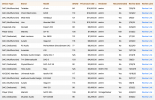Here is a review and measurements of the recent
Topping E30 II Lite DAC
View attachment 309125
Here you see it on top of the gorgeous Topping A70 Pro, to give an idea of its size.
Yes, it's a very small DAC.
I purchased it new from Audiophonics for around 100€.
This is one of the cheapest DACs with SPDIF inputs, level control and remote.
It comes with usual connectors: USB, Optical and coaxial (RCA) SPDIF inputs, and of course a pair of unbalanced analog RCA outputs.
View attachment 309123
In the box, there is also a remote, but NO power supply (nor batteries for the remote)
This for sure helped to lower the price.
The DAC may be powered from any USB source, so just a USB power cable is provided.
It worked for me from any USB power source I had at hand, including a power bank.
There are 2 modes: DAC (fixed volume) and "Pre" (where volume is variable with the remote control).
In DAC mode, the frequency is always shown.
In Pre mode, the volume is displayed (frequency is only displayed on change).
The remote also allows to select the digital input, the filter and display light level.
Topping says it's built around an AK4493s chip.
Just a detail to note: In practice, the DAC is light.
Too light maybe, and it may be pulled by heavy cables.
Measurements
Measures are performed with following equipment:
RME ADI-2/4 Pro SE, as the main ADC
For very low levels, I used the RME 12Mic-D Mic preamp/interface.
Software is Virtins Multi Instrument 3.9.8.1
There are some limitations and differences compared to Amir's testing with an Audio Precision APx555.
That's more than enough to get a good idea of the device performances though.
I'll post comments where such differences are most important.
SINAD measurement
There is only unbalanced outputs, so here it is.
View attachment 308760
You will probably get slightly better result if you measure it with the AudioPrecision.
However, this is already very good.
(This is left channel, right channel is 1dB lower.)
My measurement is not far from the
Topping RD3 TP Amir reviewed, which uses the same DAC chip, with its measured 116.8dB SINAD in unbalanced mode.
The distortion profile (H3 then H2 and H5) is also very similar.
This measurement is a bit better after powering the RME from a battery.
Dynamic range
Dynamic range is very impressive.
View attachment 308709
You read it right, that's almost 120dB of dynamic range.
Note that this figure, like all figures I publish, is un-weighted. Topping publishes a dynamic range figure wich is A-weighted.
The level you see in the plot is as seen by the RME 12Mic-D I use as ADC for this measurement. It is set for 60dB gain, 0dBFS here is -42dBu.
Linearity
View attachment 308842
I've done my best to replicate Amir's measurement here.
Multitone measurement
View attachment 308762
Multitone measurement is always very informative, as it allows to assess a lot of different things in one single measurement:
You see the noise, all kind of distortions (shown at the frequency where you'll hear their effect), the frequency response, and even the crosstalk.
We have a very good performance here.
NB: TD+N in Multitone measurement is higher than THD+N in SINAD measurement, partly because the average RMS level is much lower in Multitone. So this is quite normal.
Frequency response and Crosstalk (from Multitone)
View attachment 308713
Sine 50Hz under 600 Ohm load measurement
(Torture test)
I ran this new test Amir added in the recent SABAJ A20d measurements.
I now run this test with an home-made 600 Ohm load.
View attachment 308748
To get a comparison point,
I ran the same test WITHOUT load (so load is the unbalanced RME input, ie
45k Ohm 22.5k Ohm - in Mono mode)
As we see, the main impact is the decrease in input voltage.
View attachment 308744
Output impedance
Output impedance is in line with Topping specs (20 Ohm)
| Open circuit Voltage | V1 | 2.1138 | Vrms |
| Load resistance | RL | 613.9 | Ohm |
| Loaded circuit Voltage | V2 | 2.0454 | Vrms |
| Zo=RL*(V1/V2-1) | Zo | 20.5 | Ohm |
(Reference)
Measured at 997Hz only, with a calibrated Brymen BM869s.
IMD measurement
I ran the ususal IMD vs Level measurement
View attachment 308717
Nothing wrong to note here.
A few comments about this measurement:
I always get slightly better figures than Amir's measurement with Audio Precision, for some unknown reason. So do not compare with Amir's results.
This still gives an indication nothing wrong happens here.
The slight glitches you see in the graph around -8dBFS and -3dBFS are due to the RME ADI-2/4 Pro SE switching Input range.
I should re-run this with switching ranges manually, probably.
Jitter
Jitter performance through SPDIF is disappointing
Not likely to be audible though.
View attachment 308724
While it is (almost) text book perfect through USB
View attachment 308725
Filters comparison
NB: Black plot is F6
View attachment 308718
View attachment 308719
F1 and F3 give identical results. F2 and F6 as well.
I ran all other measurements using F6 filter.
THD+N ratio vs Frequency (90kHz BW)
Again, nothing to complain about here.
View attachment 308720
Intersample overs
As I usually do now, I tested for intersample overs, up to +3dB overload, and there is just a small hint of distortion at +3dB
This is excellent performance, and much better than other ESS DACs I have measured, on par with the RME performance.
I don't know if Intersample overshoots are actually a problem in real life, but not with this DAC anyway.
View attachment 308721
Conclusion
We have a very competent device here.
If you except the Jitter for SPDIF, which could (maybe) somehow be improved, this is impressive performance for any DAC, not to speak for a DAC costing around 100 € !
For me,
This is excellent !


